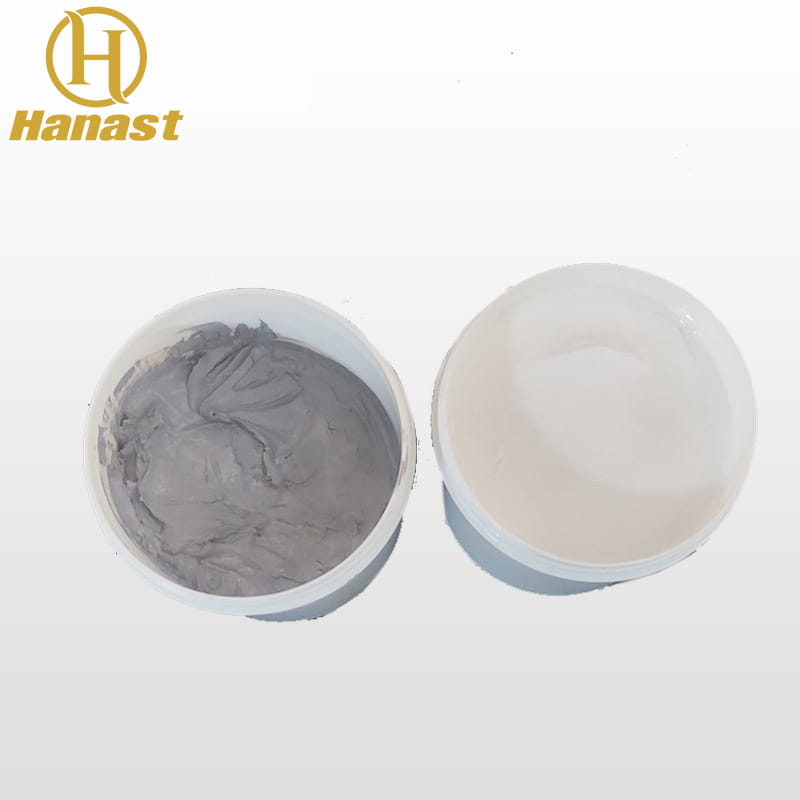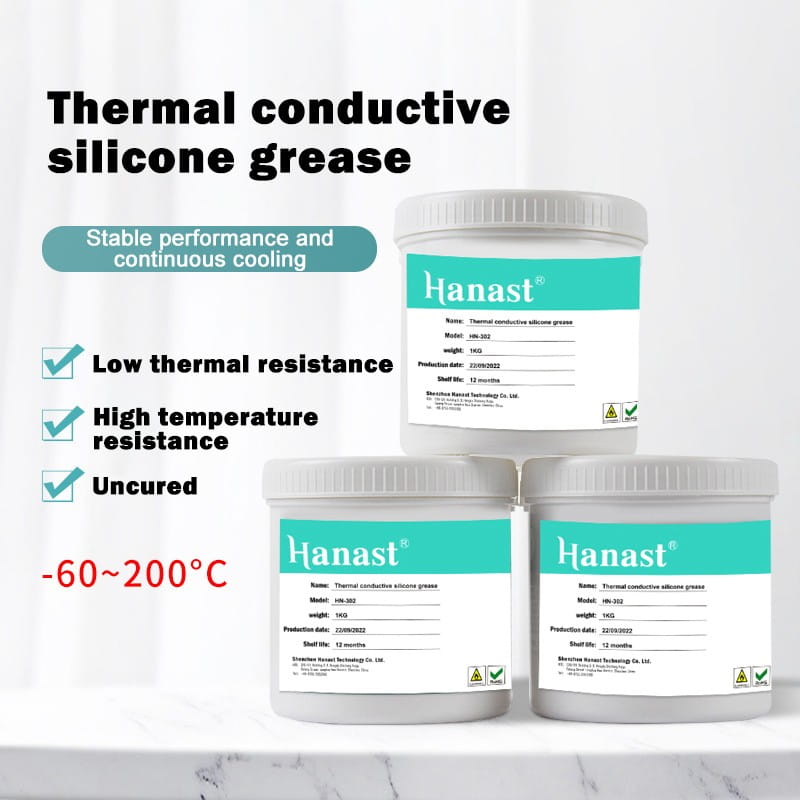Do you understand the function and performance parameters of thermal conductive silicone grease?
 Jun 09,2023
Jun 09,2023

 Hanast
Hanast
Thermal conductive silicone grease Commonly known as heat dissipation paste, also known as Thermal paste, thermal conductive silicone grease is a thermal conductive organic silicone grease like compound made from organic silicone as the main raw material and added with materials with excellent heat resistance and thermal conductivity. It is used for heat conduction and heat dissipation of electronic components such as power amplifiers, transistors, electronic tubes, CPUs, etc., so as to ensure the stability of electrical performance of electronic instruments, meters, etc.
Thermal conductive silicone grease is a kind of material used to fill the gap between CPU and heat sink. This material is also called Thermal interface material. Its function is to transmit the heat emitted by the CPU to the heat sink, maintain the CPU temperature at a stable working level, prevent CPU damage due to poor heat dissipation, and extend its service life.
In thermal management applications, even two surfaces with very smooth surfaces will have gaps when they come into contact with each other. The air in these gaps is a poor conductor of heat, which can hinder the conduction of heat to the heat sink. And thermal conductive silicone grease is a material that can fill these voids, making the conduction of heat smoother and faster.
Due to the fact that thermal conductive silicone grease belongs to a chemical substance, it also has relevant performance parameters that reflect its own working characteristics. As long as we understand the meaning of these parameters, we can determine the performance of a thermal conductive silicone grease heat dissipation paste.
Thermal conductivity coefficient
The thermal conductivity coefficient of the thermal conductive silicone grease is basically the same as that of the radiator. Its unit is W/mK, that is, the thermal conduction power when the temperature difference of the column with a cross-sectional area of 1 square meter is 1 Kelvin (1K=1 ℃) along the axial distance of 1 meter. The larger the value, the faster the heat transfer speed and the better the thermal conductivity of the material. At present, the thermal conductivity of Nuofeng electronic thermal conductive silicone grease can reach 5.2W/m.K.
Thermal resistance coefficient
The thermal resistance coefficient represents the obstruction effect of an object on heat conduction. The concept of thermal resistance is very similar to that of resistance, and its unit is also similar (℃/W), that is, the temperature difference between the two ends of the heat conduction path when the continuous heat transfer power of an object is 1W. The lower the thermal resistance, the better, because under the same environmental temperature and thermal power, the lower the thermal resistance, the lower the temperature of the heating object. The size of thermal resistance is closely related to the material used for thermal conductive silicone grease.
At present, the thermal resistance coefficient of mainstream thermal conductive silicone grease is less than 0.1 ℃/w, with excellent ones reaching 0.005 ℃/W.
working temperature
Due to the inherent characteristics of silicone grease, its working temperature range is very wide. The working temperature is an important parameter to ensure that thermal conductive silicone grease is in a solid or liquid state. If the temperature is too high, the volume of the thermal conductive silicone grease fluid expands, the distance between molecules increases, the interaction weakens, and the viscosity decreases. If the temperature decreases, the fluid volume decreases, the distance between molecules shortens, the interaction strengthens, and the viscosity increases, both of which are not conducive to heat dissipation.
The working temperature of thermal conductive silicone grease generally does not exceed 200 ℃, with high temperatures up to 300 ° C and low temperatures generally around -60 ° C. We don't need to worry about the working temperature of thermal conductive silicone grease,as it is difficult to exceed the temperature range of CPU/GPU through conventional methods.
viscosity
Viscosity is a measure of fluid viscosity, which refers to the resistance of a fluid to flow within it. It is expressed as the ratio of shear stress to shear rate of the fluid. There are many methods for measuring viscosity, such as the unit of dynamic viscosity in pascals per second.
For thermal conductive silicone grease, its viscosity is around 2500 Pa · s, and it has good flatness. It can easily be flattened around the surface of the chip under a certain pressure, while ensuring a certain degree of viscosity, preventing excess silicone grease from flowing after extrusion.
Advantages:
(1) High thermal conductivity
(2) Low thermal resistance
(3) Wide operating temperature range
(4) Low volatility
(5) Low oil separation (tends towards zero)
(6) High and low temperature resistance, water resistance, ozone resistance, climate aging resistance, etc
Disadvantages:
(1) Unable to apply on a large area and cannot be reused;
(2) The product has poor stability for a long time, and after continuous thermal cycling, it can cause liquid migration, leaving only the filling material, losing surface wettability, and ultimately leading to failure.
(3) Due to the different thermal expansion rates of materials on both sides of the interface, a "inflation" effect is created, resulting in an increase in thermal resistance and a decrease in heat transfer efficiency;
The use of thermal conductive silicone grease is not as good as applying more, but as thin as possible while ensuring that the gaps are filled. Excessive coating is not beneficial, but rather affects heat transfer efficiency.




 Home
Home




 Why does mold silicone appear to be dry on the surface and not dry on the inside
Why does mold silicone appear to be dry on the surface and not dry on the inside  You May Also Like
You May Also Like







 Tel
Tel
 Email
Email
 Address
Address












